TopoFusion Online User Manual
Note: An offline version is available as zipped html files here.
Overview
TopoFusion is a fully featured GPS Mapping program. It seamlessly displays imagery from a variety of map sources. Maps are downloaded on demand (as the user pans or zooms around the map) and cached on the user's hard drive for faster (and offline) storage.The main function of TopoFusion is to quickly display, scroll and zoom about these maps, while overlaying GPS and GIS data on top of them. To enable download of Maps all you need is an active internet connection. Opening the program will default to a world view and begin downloading satellite maps to fill the screen. Opening a GPX (GPS eXchange File) via the file menu or the browser at the bottom of the screen will move the map to display the GPX file entirely. The mouse can be used to pan about the map causing more tiles to be downloaded. Zooming in and out can be accomplished using the mouse wheel (or the plus and minus keys). As the zoom scale is changed different resolutions of maps will be downloaded.
For help about specific functions see the following topics:
Overview
Main Window
- Active File List
- Tool Bar
- Toggles
File Properties
Preferences Dialog
GPS Dialog
Profile Dialog
- Track Playback
Network Help / Network Dialog
Tips / Hints
Keyboard Shortcuts
Advanced features (described on separate pages):
Uploading Maps to Garmin GPS units
User Calibrated Maps
3D visualization
The logbook feature
Climbing Analysis
GOVSS (Running Power) Analysis
Difficulty and Effort index
Image Processing / Combo Maps
PhotoFusion - Auto placement of photos on tracks
Simplifying and Interpolating Data
Multi-Track Playback
Custom WMS server tilesets
Main Window
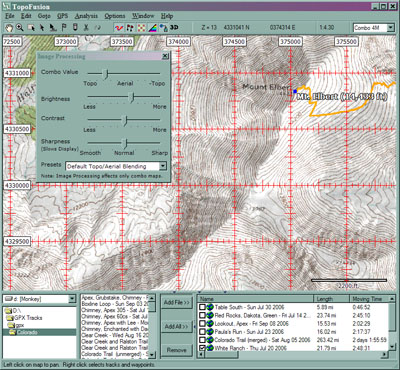
The main window is where map tiles, GPS tracks and waypoints are drawn. Above the main window is the mouse toolbar, the toggles, position and zoom information and the tileset selector. Below the main window is the Active File List and the fileview selector.
Tileset Selector
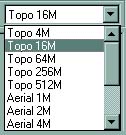
In the upper right corner of the main window is the tileset selector. It indicates which tileset is currently being shown in the map window. When the map is zoomed in or out the tileset automatically switches tilesets based on the zoom. The tileset selector can be used to change tileset by hand.
Another useful feature is that pressing the "T" key will switch between Topo and Aerial maps while maintaining the same zoom level. The "C" key switches to color aerials (Urban) while the "L" switches to Landsat maps.
Head over to Keyboard shortcuts for more useful keys.
Active File List

The lower portion of the main window contains the active files list. On the left is a simple file dialog that allows browsing of GPS files from the filesystem. On the right is a list of all active files and their corresponding attributes. Each name in the list corresponds to a single file, but each file can contain multiple tracks and waypoints.
Files are added to the active files list by using File->Open, by double clicking on them in the file view or by using one of the add file buttons. Files can be removed from the list using the unload button or through right clicking and selecting the unload file menu item. The following file formats are shown in the file list and can be read by TopoFusion:
- GPS eXchange Format (.GPX)
- ESRI Shapefile (.SHP) [Pro version only]
- Google Earth (.KML)
- Garmin Training Center History (.TCX), including power data
- Garmin Training Center Courses (.CRS)
- Magellan eXplorist Track files (.LOG)
- Magellan eXplorist Waypoint files (.UPT)
- Timex NMEA exports (.TXT)
- UTM Text files [Example] (output by Delorme's TopoUSA)
- Lat/Lon Text files [Track Example] [Waypoint Example]
- Maptech Track Export Files (.TXF)
- Maptech Waypoint Export Fiels (.MXF) [Example]
Additionally, in order to store Heart Rate, Cadence and Power data, the TCX or CRS format must be used. There is no standard way to store this data in the GPX format, so TopoFusion instead uses Garmin's standards.
If the active files list is empty when a track is added, the map will scroll and zoom to show the track in its entirety. Even when multiple files are loaded you can recenter the map on any file by double clicking on it in the active list.
Files can be disabled and enabled by clicking on their check boxes. Disabled files will not be shown on the map. The state of each file (enabled or not) will be saved for the next time TopoFusion is run.
The entire active files list can be minimized by clicking in the center of the top of the list. It can also be resized by clicking and dragging at the top of the list.
Right clicking on a file in the active list brings up a menu with options to enable or disable, remove, save and save as, and properties. Multiple files can also be selected (using shift or control) for removing and enabling/disabling. File properties brings up a dialog that shows information about the file, allows a color to be chosen for the file's tracks and shows the track points and waypoints as in a listview.
Tool Bar (Mouse modes)
All of the tools are displayed at the top of the TopoFusion main window with their corresponding icons. Hovering the mouse over one of the tools will display the name of the tools. The following are the tools available and a description of the functionality they provide.
 Pan Map - This is the default tool mode. It allows the map to be grabbed
and scrolled by pressing and holding the left mouse button. Right
clicking on a GPS track results in a context menu:
Pan Map - This is the default tool mode. It allows the map to be grabbed
and scrolled by pressing and holding the left mouse button. Right
clicking on a GPS track results in a context menu: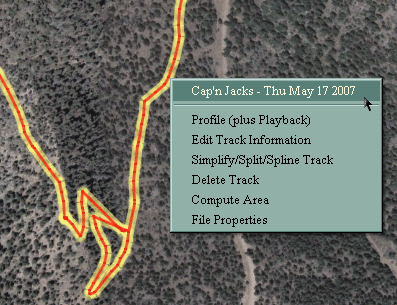
- Profile (plus Playback) - Opens the Profile/Playback dialog on the track.
- Edit Track Information - View/add text fields to this particular track.
- Simplify/Spline Track - Opens the simplify/spline dialog on the track.
- Delete Track - Deletes the track. "Undo" will undelete it.
- Compute Area - returns the area enclosed by the track in square miles and acres. Track can be open ended.
- File Properties - opens the File Properties dialog for the file the track is a part of.
 Zoom Box - This tool can be used to zoom the map to cover a specific area
of the map. Holding down the left mouse button and drawing a box around
an area, then releasing the mouse button will zoom to that area. Right
clicking for this tool performs a scaled zoom out.
Zoom Box - This tool can be used to zoom the map to cover a specific area
of the map. Holding down the left mouse button and drawing a box around
an area, then releasing the mouse button will zoom to that area. Right
clicking for this tool performs a scaled zoom out. Select Points - Allows multiple track points to be selected. Use this
tool to draw a box around multiple track points to select them. Right
clicking will unselect all selected points. While points are selected
pressing the delete key will delete them and pressing the left mouse button
and dragging will move all selected points according to mouse movements.
Release the mouse button to place the points, or press the right mouse
button to cancel the move.
Select Points - Allows multiple track points to be selected. Use this
tool to draw a box around multiple track points to select them. Right
clicking will unselect all selected points. While points are selected
pressing the delete key will delete them and pressing the left mouse button
and dragging will move all selected points according to mouse movements.
Release the mouse button to place the points, or press the right mouse
button to cancel the move. Select Point - This tool functions like the Select Points tool, except
that only a single point can be selected with it. Waypoints can also
be selected with this tool. Right click unselects any point selected.
Pressing the insert key while a track point is selected will split the two
neighboring line segments by inserting a point in the middle of each
segment. Pressing the delete key will delete the selected track point (or
waypoint). Grabbing the selected track point or waypoint and dragging it
move the point.
Select Point - This tool functions like the Select Points tool, except
that only a single point can be selected with it. Waypoints can also
be selected with this tool. Right click unselects any point selected.
Pressing the insert key while a track point is selected will split the two
neighboring line segments by inserting a point in the middle of each
segment. Pressing the delete key will delete the selected track point (or
waypoint). Grabbing the selected track point or waypoint and dragging it
move the point.  Profile Tool - Left clicking on a track (or trail network
segment) in the map window will cause it to be selected. The profile window
will pop up and the profile will be displayed.
Profile Tool - Left clicking on a track (or trail network
segment) in the map window will cause it to be selected. The profile window
will pop up and the profile will be displayed.  Mark Waypoint - Left clicking on the map in this tool mode
creates a waypoint at the coordinates clicked. The add waypoint
dialog box pops up which allows you to add information to the waypoint
and save it to any of the files in the active file list. Right
clicking on a waypoint in this tool can be used to edit waypoint
attributes after they are created.
Mark Waypoint - Left clicking on the map in this tool mode
creates a waypoint at the coordinates clicked. The add waypoint
dialog box pops up which allows you to add information to the waypoint
and save it to any of the files in the active file list. Right
clicking on a waypoint in this tool can be used to edit waypoint
attributes after they are created. Draw Track - Allows a new track to be drawn on the map. Left clicking
begins the drawing. If the mouse button is held down, free hand drawing
is allowed. Otherwise points and line segments are drawn with each press
of the left mouse button. Right clicking brings up a menu that allows
the draw track to be saved into a new file (and subsequently added to the
active list). IMPORTANT: if you do not right click and use Save As... the
drawn track will not be saved.
Draw Track - Allows a new track to be drawn on the map. Left clicking
begins the drawing. If the mouse button is held down, free hand drawing
is allowed. Otherwise points and line segments are drawn with each press
of the left mouse button. Right clicking brings up a menu that allows
the draw track to be saved into a new file (and subsequently added to the
active list). IMPORTANT: if you do not right click and use Save As... the
drawn track will not be saved. Total distance of the drawn track is shown at the bottom of the window (in the "status" bar). In this way the draw tool can be used to measure distance.
 Cut Track - Left clicking on a segment of a track will delete the segment
and split the track into two separate tracks. Both tracks stay in the
file of the original track.
Cut Track - Left clicking on a segment of a track will delete the segment
and split the track into two separate tracks. Both tracks stay in the
file of the original track. Load Maps Tool - This tool can be used to start a batch
download of tiles for an area. This provides an automatic method for
downloading map tiles without having to pan around the map to force
the download. Left click and hold the mouse button to draw a box
around the area you would like to download. When you draw the box and
lift up the mouse button a dialog box will popup giving you the option
to download aerial, topo or both types of maps. After hitting OK the
program will download all zoom levels of tiles for that area and show
the download's progress.
Load Maps Tool - This tool can be used to start a batch
download of tiles for an area. This provides an automatic method for
downloading map tiles without having to pan around the map to force
the download. Left click and hold the mouse button to draw a box
around the area you would like to download. When you draw the box and
lift up the mouse button a dialog box will popup giving you the option
to download aerial, topo or both types of maps. After hitting OK the
program will download all zoom levels of tiles for that area and show
the download's progress. Additionally, occasionally map tiles are downloaded incorrectly from Terraserver due to network errors or hardware failures. Such tiles will be displayed with an ERROR in the upper left corner, or they will simply look incorrect. Clicking on a tile with this tool (without drawing a box) will cause it to be downloaded again from Terraserver. NOTE: if a tile is unavailable (doesn't exist on Terraserver) it will be shown as a "white noise" tile--this is normal and reloading the tile will do nothing. This tool can also be used to force download of tiles in the case of Terraserver updating its imagery with new maps for an area.
 Merge Tool - This tool can be used for a variety of purposes.
Left clicking on a single track acts much like the Profile tool. The selected
track is highlighted and the profile window comes up for that track. Left
clicking on another track will create a new track that is the combination of
the two tracks, merged in an "intelligent" way. This means that the second
track may be reversed if its ending point is closer to the
ending point of the first track.
Merge Tool - This tool can be used for a variety of purposes.
Left clicking on a single track acts much like the Profile tool. The selected
track is highlighted and the profile window comes up for that track. Left
clicking on another track will create a new track that is the combination of
the two tracks, merged in an "intelligent" way. This means that the second
track may be reversed if its ending point is closer to the
ending point of the first track.
The resulting merged track will be shown highlighted on the map and its profile will be updated in the profile window. In this way new tracks can be formed from trail networks (and other tracks) by clicking and adding them in succession. If the last segment added is in the wrong order (despite the smart mergine), it can be reversed by pressing the "v" key. To determine what direction a track is stored in a small blue dot continuously travels the track in order. Use the this dot to ensure you are adding segments in the correct direction. Right clicking while in Profile tool mode brings up a menu with the following functions:
- Reverse Last Segment - performs same function as "v" key.
- Remove Last Segment - removes the most recently added segment from the merged track. Can be done repeatedly to remove all segments.
- Clear All Segments - clears all segments
- Save as... - brings up a dialog to save the merged track into a new file; it will be subsequently added to the active file list
TopoFusion Basic Users: The same functionality in the Merge Tool is available by the Profile tool. There is no Merge Tool in TopoFusion Basic.
Toggles
Next to the tool bar are the toggle buttons:

 Toggle Map Status (Tracks) - Toggles whether tracks are drawn or not.
If this toggle is off, no tracks will be drawn under any circumstances.
Toggle Map Status (Tracks) - Toggles whether tracks are drawn or not.
If this toggle is off, no tracks will be drawn under any circumstances.
 Toggle Map Status (WayPoints) - Toggles whether waypoints are drawn or not.
If this toggle is off, no waypoints will be drawn under any circumstances.
Toggle Map Status (WayPoints) - Toggles whether waypoints are drawn or not.
If this toggle is off, no waypoints will be drawn under any circumstances.
 Toggle Map Status (Maps) - Toggles whether map tiles are displayed or not.
Toggle Map Status (Maps) - Toggles whether map tiles are displayed or not.
 Display Photo Toggle - Toggles whether photo thumbnails are
displayed for waypoints with the Photo symbol. See PhotoFusion. (TopoFusion Pro only)
Display Photo Toggle - Toggles whether photo thumbnails are
displayed for waypoints with the Photo symbol. See PhotoFusion. (TopoFusion Pro only)  Toggle Elevation Shading - Toggles whether tracks are shaded by their
elevation or not (if the tracks have elevation data available).
Toggle Elevation Shading - Toggles whether tracks are shaded by their
elevation or not (if the tracks have elevation data available).
 Toggle Internet Downloading - Toggles whether tiles are downloaded from
Terraserver or not. Turn this option off to use offline (ie with a laptop
not connected to the internet).
Toggle Internet Downloading - Toggles whether tiles are downloaded from
Terraserver or not. Turn this option off to use offline (ie with a laptop
not connected to the internet).
 Toggle 3D/2D Visualization - Toggles between 3D and 2D viewing modes.
See the 3d page for more information.
Toggle 3D/2D Visualization - Toggles between 3D and 2D viewing modes.
See the 3d page for more information.
File Properties Dialog
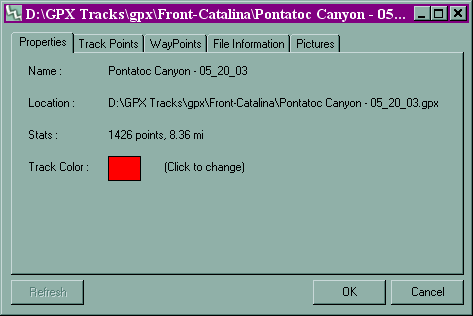
To access the file properties dialog, right click on a file in the active list and select "File Properties." Or, right click on a track or waypoint from the file in the main map window and select "File Properties."
In the properties tab, statistics and information about the file are listed. The color of the tracks in the file can be changed by clicking on the color square.
The Track Points tab displays a list of all the track points in the file. This list can be sorted on any of the attributes. Double clicking on a point will move the map to center on that point and highlight it in the map window. Individual points can be selected and deselected using shift and control. When points are selected right clicking gives the following options:
- Delete Point(s) - delete the selected points from the file
- Convert to Waypoint - converts a track point to a way point. The Add Waypoint dialog will come up, allowing you to edit the attributes of the new waypoint. All fields are copied, including the time.
Drag and Drop waypoint management - To move waypoints between GPX files, simply open up a File Properties dialog box for both files. Go to waypoint tab in both, and grab the waypoint(s) you wish to copy. Highlighting them and dragging them into the destination file's waypoint list will copy the waypoint into that file.
Show Points Button - If a file has more than 1000 points, the list of track points will not automatically be loaded (since this can take some time). If the list track point and waypoint lists are empty, you need to hit the Show Points Button to fill them in. Also, The list of track points and waypoints in file properties behaves as file properties in windows explorer does: it is not always kept in synch. If the file is editted in the map window (points deleted, for example), the "Refresh" button will become enabled. Pressing this button will reload the lists of track points and waypoints in the dialog.
The File Information tab gives you access to attributes for the entire file. Examples are Name, description, author, author's email, etc. These are useful when publishing GPS data in the GPX format. They are also used in the PhotoFusion pages.
The Pictures tab sets up the parameters for the PhotoFusion georeferencing digital photo feature.
Preferences Dialog
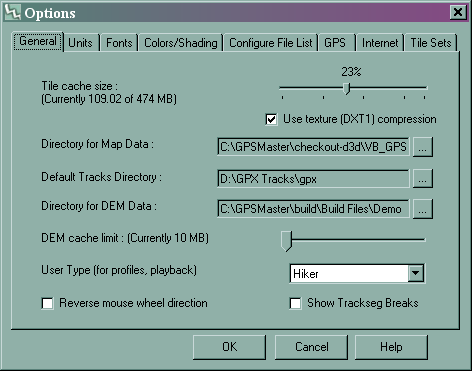
Selecing Options->Preferences brings up various TopoFusion configuration dialogs. All options are saved in TopoFusion.ini. Deleting this file (found in "Program Files\TopoFusion" will reset all settings to default.
General Tab
- Memory cache size: This slider specifies what percentage of your system's free memory should be used by TopoFusion to cache map tiles. Note: There is no limit to the disk map cache -- once you download a map it is always present in the cache. The more map tiles stored in the memory cache the faster map scrolling will be. An estimate of the amount taken is shown on the dialog.
- Use texture (DXT1) compression: Specifies that locally cached maps should be stored in DXT1 format, rather than jpeg and gif. Advantages to DXT1 include faster load time and much lower memory usage. The only disadvantage is slightly higher disk usage. See this forum topic for more info.
- Directory for Map Data: Clicking the "..." button allows you to configure the directory that TopoFusion uses to store Map Data. IMPORTANT: this option does not take effect until TopoFusion is restarted. Two files will be created in the directory specified: Maps0.dat and MapIndex.dat. Both files must be present for TopoFusion to use the stored maps. Storing maps in a single file greatly reduces the amount of disk space taken and also decreases loading time. If your Maps0.dat file grows larger than 650 mb, a new map file, Maps1.dat will be created (and so on). This is for easy archiving and to avoid maximum file size restrictions in windows.
- Default Tracks Directory: Clicking the "..." button allows you to configure the startup directory for the fileviewer on the map TopoFusion map window. On startup TopoFusion will change to this directory. Files saved or created without an absolute path will also be saved in this directory.
- Directory for DEM Data: TopoFusion automatically downloads 3D elevation (DEM) data by default, but it can also use locally stored .DEM files. This is the directory where TopoFusion will look for .DEM files.
- DEM cache limit: Locally stored DEM data is cached in memory. This is the size of this cache. For more on .DEM files, see: the 3D page.
- User Type: Selects which icon type (hiker, cyclist, etc) is displayed for trip playback, profiling, live tracking, etc.
- Reverse mouse wheel:Reverses direction for zooming in/out with the mouse wheel, for those used to Google Earth style zooming.
- Show Trackseg breaks: If selected, breaks in tracksegs will be shown as black links on tracks in the map. Trackseg breaks are typicall due to losing signal, or turning the GPS on and off.
- Units of Distance: Switches between Standard and Metric units for all displays.
- Coordinate Type: Selects either UTM grid or Lattitude/Longitude coordinates for all displays. Different display options for Lat/Lon coordinates are included as well (deg, min, sec).
- Datum Selection: Allows the selection of map datum. This selection applies to all displayed coordinates as well as those entered by hand (waypoints for example).
- Show UTM Grid on Map: Displays numbered grid lines on the maps. Choices include Auto (variable) grid spacing and various fixed spacings.
- Show pace instead of speed: Select this option if you are a runner and would like to see pace (in minutes per mile) instead of speed (miles per hour) in various places throughout the program.
- Limit Speed to: Computing speeds from GPS tracks can sometimes be problematic. Especially max speeds can be off due to a few stray GPS points. Use this setting to 'throw out' speeds that are too high. For example, a runner may want to set this at 20 mph, or so, unless you are REALLY fast! This will ensure more accurate stats.
- Min speed to be considered "moving": Moving time calculations are used in several places in the program. This threshold value controls how fast the GPS must be moving to be considered "moving."
- Track Shading: A color wheel of five colors is used to shade tracks (typically according to elevation). You can set each of these manually by clicking on the color boxes. Or you can choose between various presets. A custom preset can be saved using the Save as custom button. Custom setting can be recalled in the preset drop down.
- Shade tracks by: By default, tracks are shaded according to their elevation. Options for shading by speed and grade are provided here.
- Choose waypoint text field to display: Typically the name of the waypoint is displayed. However, it can be useful to display other text fields (the description field, for example) on the map instead. Be careful with this setting--if a field is blank, no text will be displayed, just the waypoint symbol.
GPS Tab - The GPS tab is used to setup your GPS unit.
- Com Port: Selects the com port the GPS unit is attached to.
- GPS Type: Selects the type of GPS unit.
- Baud Rate: Selects the baud rate to use for transfer. Garmin units default to 9600 baud. Magellan units can use higher baud rates which may or may not work depending on your specific unit. Newer units should support the higher baud rates.
- Proxy: Click the "Use Proxy Server" checkbox to enable proxy support. The servers TCP port can also be configured (default = 1080).
- Server Connection: Configures the number of active connections to Terraserver allowed at one time. Each connection is a single thread of execution. For slower connections this should be set to a lower value. Very high speed connections will benefit from more connections (greater than 10).
- Show/Download Tilesets: All tilesets can be disabled or enabled here. Very useful for off-line use (in the case of missing tilesets). Also good for slow connections (prevent loading of high resolution tiles). A few tilesets are somewhat redundant (Topos 2M, 8M and 32M) since they are just resizes of other maps. Most people leave these turned off. If you want to zoom in fully on a particular map, you can disable all smaller tilesets.
- Tileset Preference: Controls the selection of tilesets (1M per pixel, 4M per pixel, 16M per pixel, 64M per pixel) for various zoom levels. Essentially, it chooses the point where TopoFusion will decide to switch between tilesets when you are zooming in/out. Either the smaller tilesets are being blown up to fit the zoom or the larger tilesets are being shrunk. Shrinking tilesets provides higher quality maps, but will run slower for force more map downloading. For producing maps for the web, use a "shrink lower tilesets" setting. But while zooming and panning around, use a more conservative setting based on your hardware's capabilities.
- Zooming smoothness: Controls the number of intermediate steps drawn between zooming. At the left no intermediate maps will be drawn and at the right many will be.
GPS Dialog
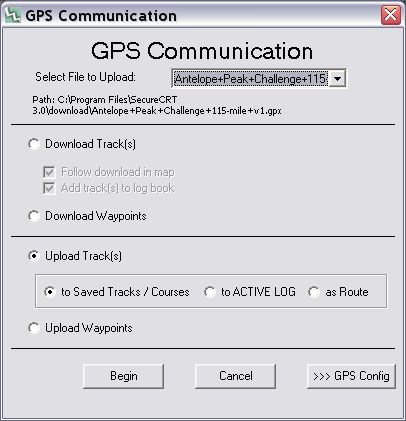
The GPS Dialog provides communication to GPS receivers.
The parameters used for GPS tranfer (type of Unit, and USB or Serial) are set in the Options->Preferences dialog, accesible from the main menu or by hitting the "GPS Config" button.
There are four options in the GPS Dialog for uploading and downloading tracks and waypoints.
Uploading means sending data to the GPS, while downloading is receiving it from your GPS.
Tracks and waypoints can be downloaded into a new file or an existing file. Use the drop down box to select a "-New File-" or one of the files that is currently loaded in the active file list. If "-New File-" is selected, the "save as.." dialog box will come up after the transfer has finished. You are then able to save the file in whatever directory you choose.
To upload the tracks or waypoints in a file, select the appropriate option and file and begin the transfer.
For a detailed tutorial on uploading high resolution tracks to Garmin units (broken down by different GPS types) see Uploading tracks using TopoFusion
For all transfers a progress bar will be shown at the bottom of the dialog. If there is a communication error (wrong port, GPS not on, GPS not connected) an error will be displayed in the dialog.
Garmin users can select whether tracks are uploaded to the ACTIVE LOG or the saved tracks portion of their unit. This option is only functional on older units that have saved track / active functionality. This option does not apply to newer units that come up as removeable USB drives when plugged in.
In general we recommend uploading to 'saved tracks', unless you are uploading a GPS file with more than twenty individual tracks. In this case you may wish to experiment with uploading to the Active Log. Remember, however, than the active log will get overwritten by newly collected GPS points as you travel.
Tracks can also be uploaded as routes using the "as Route" option. This will convert every track point into a waypoint and form a route on the GPS. The route will be given the ball symbol so that it can be differentiated (and deleted) easily from other waypoints. It is recommended that you simplify (see: simplifiying) a track to a smaller number of points before uploading it as a route. Most Garmin units can handle routes of at least 100 points, some 250.
Profile Dialog (also Track playback)
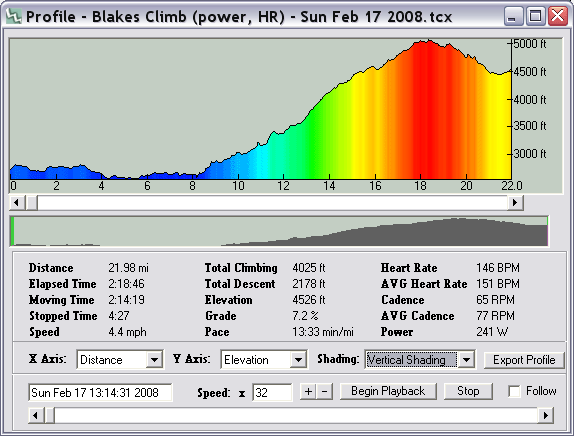
The profile window is used to show an elevation profile of a selected track. It can also be used to playback a track in real time. The profile window can be opened by left clicking on a track with the profile tool, or by right clicking on a track (using the Pan Map tool) and selecting the Profile option.
Below the profile window various statistics about the track are listed (distance, climbing, elapsed time, etc). As the mouse is moved right and left across the profile a cross-hair will highlight the position of the track on the profile. Back in the map window a marker will be placed at the position corresponding to the mouse position on the profile. The track will only be drawn to that point. The statistics in the profile dialog will also be updated to indicate the progress to that mouse position.
Left and right clicking on the profile zooms the range in and out (respectively). The master profile (below the main profile) allows you to further control the range of the profile window by clicking and dragging the colored bars on either side of it. The master profile can be used in this way to gain more precise control over the range of the profile.
When using the profile tool a blue dot will continuously cycle through the track, in order, on the main map window. This shows the current direction of the track. To reverse the direction of the track right click in the main window and select Reverse Last Segment. This feature is important for creating new tracks from trail networks as it ensures that segments of the graph are merged in the correct direction. Left clicking with the profile tool on another track will append it to the current track, in order, as described in the Profile Tool section. If you want to simply profile another track separately, right click and select Clear All Segments before clicking on another track. Alternatively, use the Pan Map tool to profile tracks using the right mouse button. Tracks and segments profiled with the Pan Map tool are not merged/appended.
The elevation profile will simply be blank (or flat) if the track you are profiling contains no elevation data. It will still update the position on the main map window with mouse movement, however.
Track Playback:
If the track contains timing information the playback feature (lower portion of the profile dialog) will function. The scroll bar indicates the full duration of the track and the current position. Pressing the "Begin Playback" button will start the playback. Time progresses at a rate multiplied by the Track Playback Speed. The position of the track at the current elapsed time will be updated on the profile as well as back in the main window. To stop or pause the playback, press the appropriate button. The scrollbar can be used to set or move the current time position of the playback.
Selecting the Follow checkbox will keep the map centered on the current position of the track. This feature works for both track playback and profiling.
Profile Shading Options:
Three shading options are available: No shading, Horizontal shading Vertical shading and Speed shading. Horizontal and Vertical shadings are based on the relative elevation of the profile and will match the elevation shaded tracks in the map display window. Speed shading will color the profile based on the speed traveled on the track.
Network Dialog
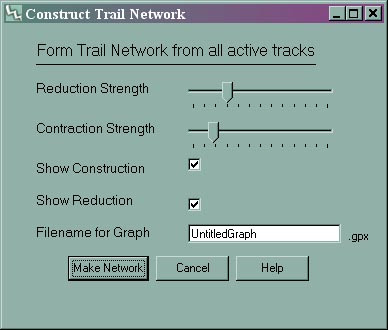
The network dialog is used to create trail networks from a collection of GPS track logs. All tracks that are loaded (are listed in the Active Files list) and enabled (they have a check mark next to them) will be merged to form a trail network. This means that before the network dialog is open you should load all the tracks you want in the network and ensure that they are enabled.
Creating and reducing trail networks involves a complicated algorithm, the details of which have been published in an IEEE/ACM conference proceedings. In broad terms it works by identifying sections of tracks that are close and similar enough such that they are actually representations of the same trail or road. The algorithm averages these segments together to eliminate duplicates.
There are two sliders that control the network process:
Reduction strength is a measure (in meters) how how close parallel tracks must be to each other in order for them to be considered the same trail. They are then reduced to one track.
Contraction strength. A contraction is a "spur" in the network (maybe due to going off the trail to fix a flat, or to look at a view point) that isn't really a trail. Sometimes they come about in the process of reduction. Contraction strength means any trail segment with distance less than the slider value (in meters) will be deleted or merged into the network. It's deleted if it's a spur; merged if it's a link between two nodes in the graph.
Larger values for reduction and contraction strength will result in tracks being considered the same (and subsequently averaged together) when they are further apart.
Note that the network algorithm does not reduce the number of points in your track logs. For that you should use the Simplify/Spline tool.
Two check boxes enable progress of the algorithm to be shown on the map. There are two stages: construction and reduction. Since the algorithm can be slow for large numbers of tracks, disable both of these options if you are concerned with speed since they slow the procedure down considerably. A progress bar updates as the procedure progresses.
The filename dialog selects the name of the GPX file to save the resulting network to. Unless an absolute path is provided the GPX file will be placed in the default track directory.
It is likely that the network algorithm will improve over time, but in order to obtain perfect trail networks some degree of user intervention will always be necessary. Some tips for creating good networks:
- The most important factor in the quality of trail networks is in
the input tracks themselves. The better the tracks obtained, the
easier it will be to create accurate networks. Things like stray
points, extra spurs and "standstill" GPS errors will often result in
false segments and intersections.
- If you are interested in obtaining an excellent network, do some work
cleaning up your tracks before you run the network algorithm. Delete
stray points, clean up clumps of points and delete false spurs (where
you may have gone the wrong way for a bit on a track, then turned
around). You can try increasing the reduction and contraction sliders
as well -- the higher the value, the more the track will be cleaned up
by the code. However, increasing the sliders can result in reducing
two trails that are actually distinct trails into a single trail.
Experiment with different values to see the difference.
- Sometimes the network algorithm will produce trail intersections
in the wrong place, or even miss intersections at all. This is
because if two tracks do not actually intersect the algorithm will not
find the intersection (or they could parallel each other for a bit,
then finally intersect). Fixing this problem is easy--just edit your
tracks and force the tracks to intersect at the same point. Code for
handling this automatically is under development.
TopoFusion Tips / Hints
- Press "T" on the keyboard to switch between Topo and Aerial map mode while maintaining the same zoom ratio.
-
Press "A" on the keyboard to cycle between Aerial, Topo and Combo map modes.
-
Scrolling the mouse wheel will control the zoom level, and will
automatically switch between tilesets.
-
The map window can be panned by using the arrow keys. The plus and
minus keys also control the zoom level.
-
Double clicking on a file in the active list moves and zooms the map
to show the entire file.
-
When a single point is selected pressing insert will insert two points
on the neighboring segments.
-
When a single point is selected pressing delete will delete it.
-
Using the select point tool you can right click on Waypoints to get Waypoint
menu that allows you to edit a waypoints attributes.
-
The files in the active list can be sorted by their column values by
clicking on the column header to sort by. The widths of the columns
can also be changed like standard windows controls.
-
Left and right clicking on the profile zooms the range in and out
(respectively).
-
The master profile (below the main profile) allows you to further control the
range of the profile window by clicking and dragging the colored bars
on either side of it.
Keyboard shortcuts

| View Mode: | |
| t | Change between topo and aerial maps |
| a | Change between topo, aerial, and combo maps |
| 3 | Change between 2d and 3d viewing |
| b | Switch to B/W aerial map |
| c | Switch to Color aerial map |
| l | Switch to Landsat map (L key) |
| o | Switch to Combo map (O key) |
| u | Switch to Urban aerial map (U key) |
| r | Regenerate 3d model |
| ; | Decrease vertical exaggeration (3d mode) |
| ' (single-quote) | Increase vertical exaggeration (3d mode) |
| Combo Mode: | |
| [ | Use less aerial (more topo) |
| ] | Use more aerial (less topo) |
| - | Less brightness |
| = | More brightness |
| 9 | Less contrast |
| 0 | More contrast |
| Movement: | |
| arrow keys | Pan map |
| +, pgup | Zoom in |
| -, pgdn | Zoom out |
| Tool Selection: | |
| h | Pan tool |
| z | Zoom tool |
| s | Select multiple points (rectangle) tool |
| p | Select single point tool |
| f | Profile tool |
| w | Mark waypoint tool |
| Miscellaneous: | |
| insert | insert points (if point selected) |
| delete | delete point(s) (if point(s) selected) |
| v | reverse last segment (merge/profile tool) |
Mouse Interface
| Pan Mode: | left button drag: | drag map (pan) |
| right click: | select tracks/waypoints/pictures | |
| Zoom Mode: | left click: | Zoom in and center on targetted area |
| left button drag: | Zoom to rectangle drawn | |
| right click: | Zoom out | |
| Select Multiple Points Mode: | left click drag: | Select points in rectangle drawn |
| right click: | Deselect all points | |
| Select Single Point Mode: | left click: | Select point |
| right click: | Deselect point | |
| Profile Tool Mode: | left click: | Select track |
| right click: | Bring up Profile/Merge menu | |
| Mark Waypoint Mode: | left click: | Mark Waypoint at target |
| Cut Tool Mode: | left click: | Cut track at target link |
| Load Maps Tool: | left click: | (Re)load selected tile |
| left click drag: | Load maps in selected area | |
| 3d Mode: | left click drag: | Rotate 3d Model |
| right click drag: | Translate 3d Model | |
| Mouse wheel | Zoom in/out (all modes) | |
